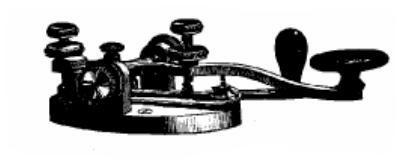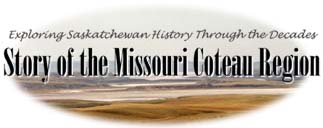Telegraph
 The telegraph was the main way to communicate before
telephones were invented. It used a series of fast and short clicks
that were electronically sent. Each letter of the alphabet and
its punctuation had a series of long and short clicks. Samuel
L. B. Morse invented it in 1832.
The telegraph was the main way to communicate before
telephones were invented. It used a series of fast and short clicks
that were electronically sent. Each letter of the alphabet and
its punctuation had a series of long and short clicks. Samuel
L. B. Morse invented it in 1832.
 The
telegraph was used frequently by businesses, but rarely for personal
reasons. Before the invention of the telephone, it was the fastest
and most reliable from of communication. News of national and
international interest was flashed over the wire, probably the
most important of which was that Germany had been defeated by
the Allies in WWII.
The
telegraph was used frequently by businesses, but rarely for personal
reasons. Before the invention of the telephone, it was the fastest
and most reliable from of communication. News of national and
international interest was flashed over the wire, probably the
most important of which was that Germany had been defeated by
the Allies in WWII.

Telephones
 The
telephone was another important invention to be introduced during
the homesteading period. The first phone came to the Missouri
Coteau region in 1916. The holes for telephone poles were dug
with picks, shovels, bars and augers.
The
telephone was another important invention to be introduced during
the homesteading period. The first phone came to the Missouri
Coteau region in 1916. The holes for telephone poles were dug
with picks, shovels, bars and augers.  Phones were large and hung on the wall.
The only phones available in the Missouri Coteau region was "party
lines", which meant that six or even ten families used the
same telephone line. Each family would have a different ring to
alert them that the call was for them, perhaps one long and two
short. Since there was no dial or number board, callers used the
handle on the side of the telephone box: turning it one complete
circle cause a long ring, turning it a quarter circle caused a
short ring. It was rare to have a conversation and not have anyone
else listen in. One of the minor setbacks was that the homesteaders
were only allowed to use the phone until midnight unless there
was an emergency. The phone was also used to advertise local dances,
box socials and other main events. To dial out you would have
to call the operator and he/she would dial the number for you.
Phones were large and hung on the wall.
The only phones available in the Missouri Coteau region was "party
lines", which meant that six or even ten families used the
same telephone line. Each family would have a different ring to
alert them that the call was for them, perhaps one long and two
short. Since there was no dial or number board, callers used the
handle on the side of the telephone box: turning it one complete
circle cause a long ring, turning it a quarter circle caused a
short ring. It was rare to have a conversation and not have anyone
else listen in. One of the minor setbacks was that the homesteaders
were only allowed to use the phone until midnight unless there
was an emergency. The phone was also used to advertise local dances,
box socials and other main events. To dial out you would have
to call the operator and he/she would dial the number for you.
 Another
type of phone used in this area was the barbwire phone. This phone
was introduced in 1945. A barbwire phone was installed by using
one pasture fence line for each user. The return feed was made
with a grounding post drove into the ground. In the early days
people would use the same government phone box with switches and
an extra bell. They then moved on to use old telephones, which
were available and installed separately. When the barbwire telephone
first came out, the wires were stapled directly to the fence posts.
This didn't work well. When it rained it would weaken the transmission.
Later on insulators were put on and reception would be clear.
The barbwire was a good way of communicating; it tended to be
very reliable and didn't break down like the government telephone
would. This telephone was especially handy when a bull got out
of pasture and did not completely break the wire, everybody would
listen on their end of the phone and they would tell each other
where the lost bull was heading. This type of phone lasted until
a modern government telephone system was put in with underground
wires.
Another
type of phone used in this area was the barbwire phone. This phone
was introduced in 1945. A barbwire phone was installed by using
one pasture fence line for each user. The return feed was made
with a grounding post drove into the ground. In the early days
people would use the same government phone box with switches and
an extra bell. They then moved on to use old telephones, which
were available and installed separately. When the barbwire telephone
first came out, the wires were stapled directly to the fence posts.
This didn't work well. When it rained it would weaken the transmission.
Later on insulators were put on and reception would be clear.
The barbwire was a good way of communicating; it tended to be
very reliable and didn't break down like the government telephone
would. This telephone was especially handy when a bull got out
of pasture and did not completely break the wire, everybody would
listen on their end of the phone and they would tell each other
where the lost bull was heading. This type of phone lasted until
a modern government telephone system was put in with underground
wires.
Radio
 After
1920 the radio was one of the best forms of entertainment of the
time, although few people were able to afford one. Listeners could
hear music, stories, "soap operas", and of course news.
Hockey games were broadcast on the radio were very popular, and
families would gather around the radio to listen. During WWI everyone
who owned a radio had to pay a two dollar yearly tax to help in
the war effort.
After
1920 the radio was one of the best forms of entertainment of the
time, although few people were able to afford one. Listeners could
hear music, stories, "soap operas", and of course news.
Hockey games were broadcast on the radio were very popular, and
families would gather around the radio to listen. During WWI everyone
who owned a radio had to pay a two dollar yearly tax to help in
the war effort.


